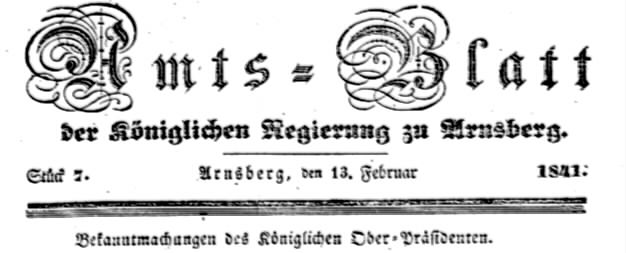The "Schnadgang", an old tradition from Westphalia

The "Schnadgang", an old tradition from Westphalia

In some towns "Grenz-" (border, boundary) or "Schnadenzüge" were still organized. These have led, for example in the municipality of Brilon, to a lot of rough exzess in newer times.
There is no reason and no necessity for such processions, because after the completion of the land registration there are no possibilities to suppress the evidence of borders. In case the border is not evident the proper authorities will check this and it is not necessary to do this by the attendance of the people. Therefore the local authorities may not give any permission due to an order of the royal ministry of inner affairs and the police. They who organize such a "Grenzzug" without permission will get a fine of 50 Thlr. or will be sent to prison for 4 weeks, everybody who attends a "Grenzzug" will get a fine of 1 to 5 Thlr. or will be sent in prison from 2 up to 8 days.
Arnsberg, the 3. February 1841
Remark: This prohibition of the traditional "Schnadgang" around the city of Brilon was repealed in 1848 by the Prussian King, Friedrich Wilhelm IV.
Dr. Josef Lappe published about "The Schnadgang ...". I'll give an abridged and summarizing version :
From time to time newspapers report that a "Schnadgang" or "Schnadzug" is planned or already has taken place again somewhere in Westphalia. To the understanding of the readers a meaning of the name "Schnadgang" then must be given."Schnadgang" is a procession for the purpose of inspection the marks of the borders of a town or village in former times. The press draws the attention to the fact, that the Schnadzug is an old tradition, which today seems truly strange, because its meaning has no longer a function. In the middle ages from time to time it was usual to check the borders of the villages and towns by a walk or ride to look how far the right reaches.
The "Schnadgang" was used to avoid border disputes. If boundary markers disappeared, one tried to re-establish the marks through the statements of the old people or tracing the old "Schnad" (border, boundary). Expressions were used in the reports as: a tree became "Geschnadet", that is, it became signs, e.g. a cross was cut in or, if trees were missed, boundary stones (Schnad-stones) were replaced in the earth.
The "Schnad" demanded a wide-spread knowledge from the farmers and the citizens so that they were in a position to know how far their rights would reach. That was the purpose of the "Schnadgang.
The "Schnad" was made known to young people quite insistently. The horn of the hunters were blown on the Schnadstein and quite a number of salvos were passed on from the flints so that the boys remembered the place later. It happened that the young farmers got a thrashing at the Schnadstein or were held tight on the arms and legs in order to keep the "Schnadgang" and the boundary stone in memory of pain.
There is a little rhyme: "put him on the stone with the arse, that he wouldn't forget the boundary stone " (the translation in english doesn't sound as a rhyme).
The "Schnadgang" lost its purpose and legitimacy by the dividing of the common fields and giving them into privat property, the reparceling the fields and with the establishing of a land registration. They got superfluos but were still allowed in a disposal of the Prussian Ministery of Inner Affairs by July 6, 1817, however explained as no more necessary . They were forbidden then completely some years later. The government to Arnsberg ordered at 3. February 1841 (Official Bulletin of the government to Arnsberg). (1841 side 44 No. 70):
|